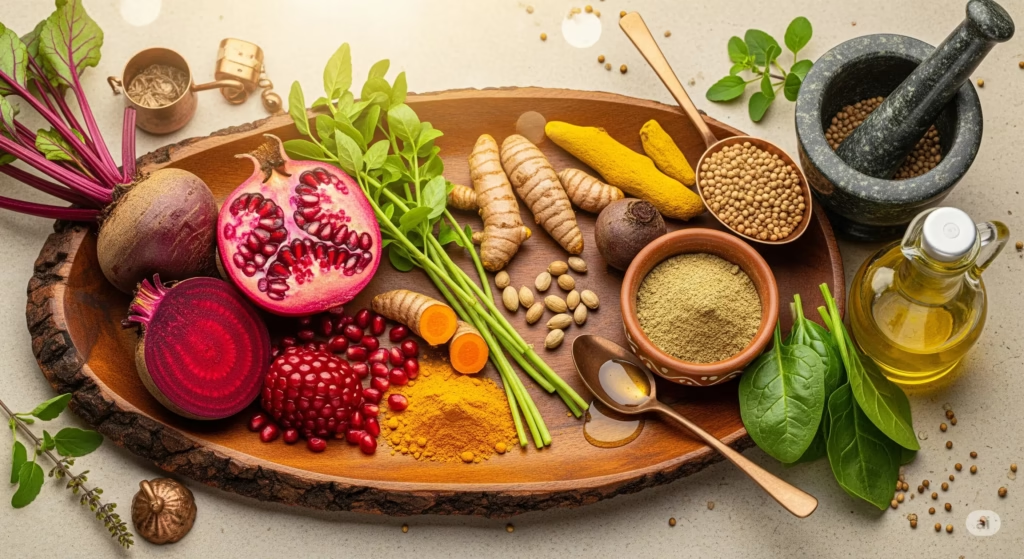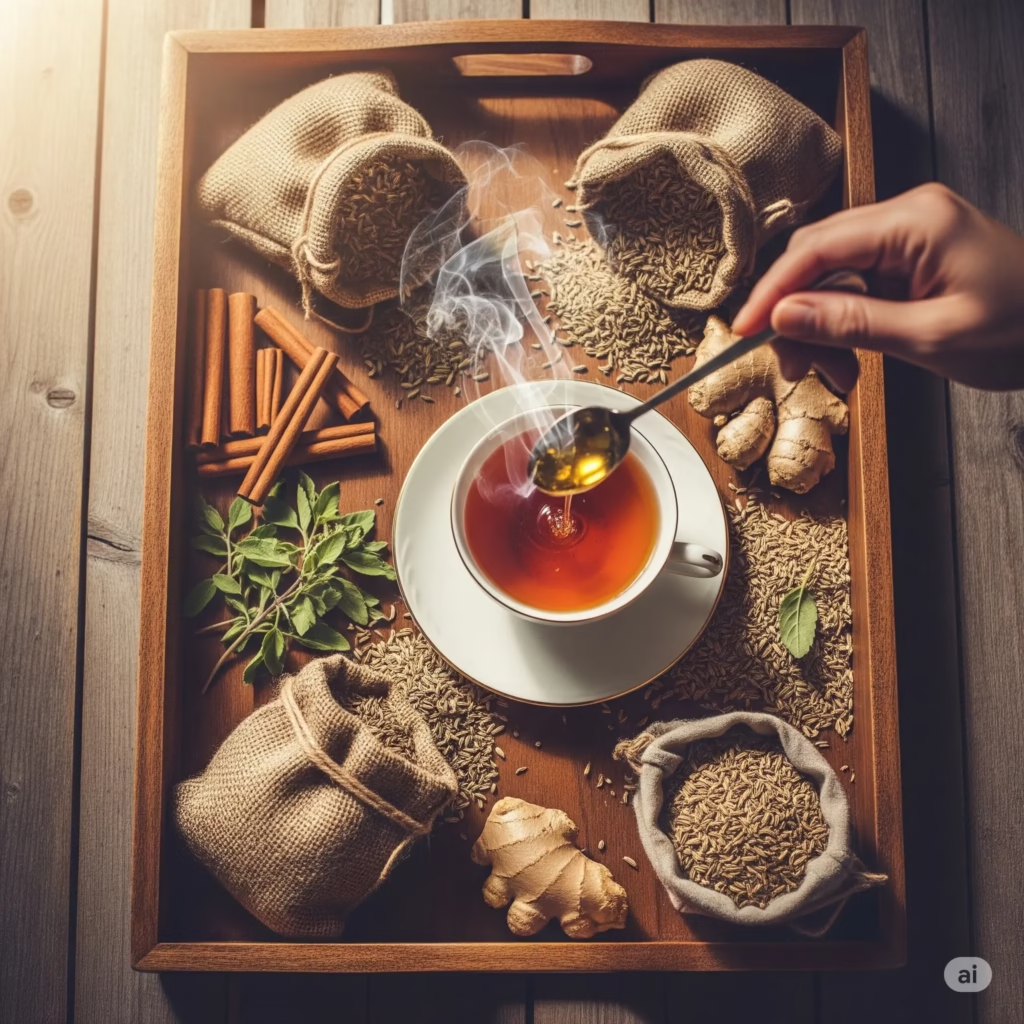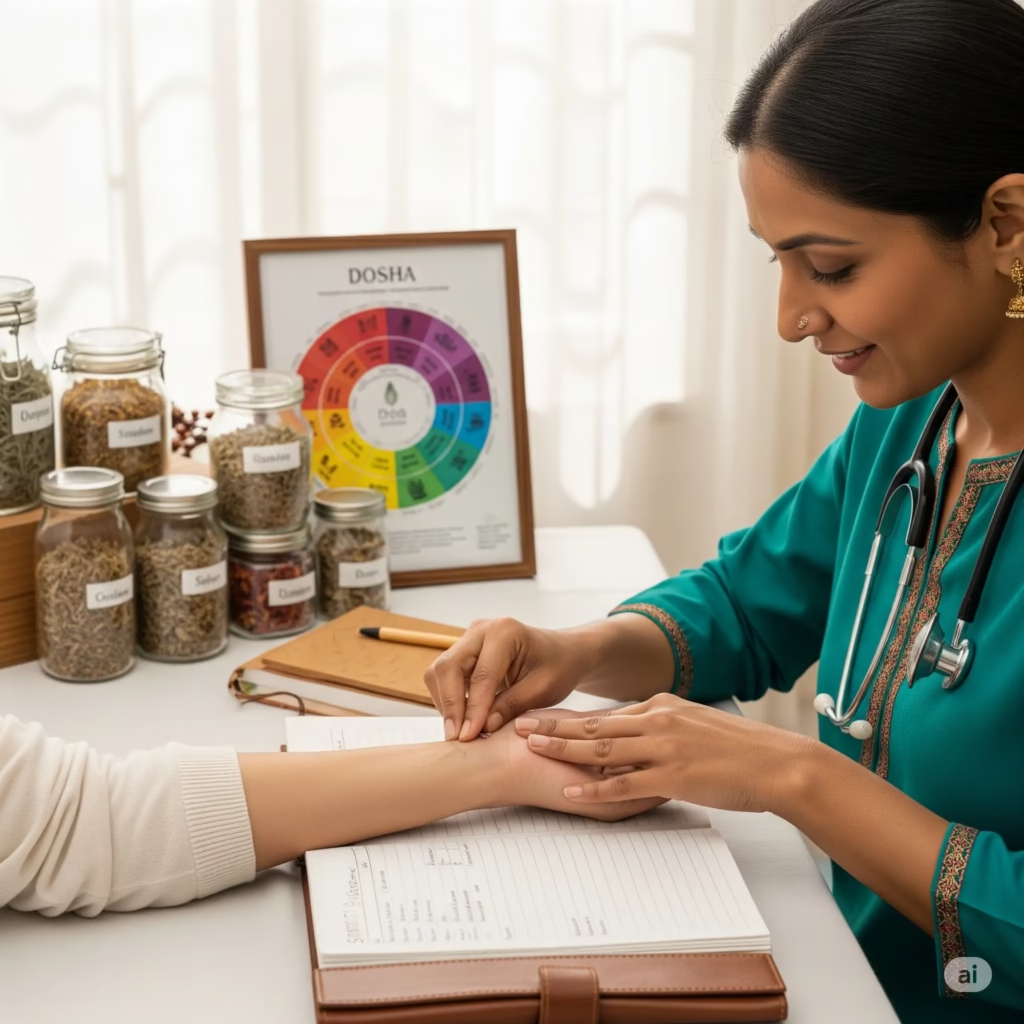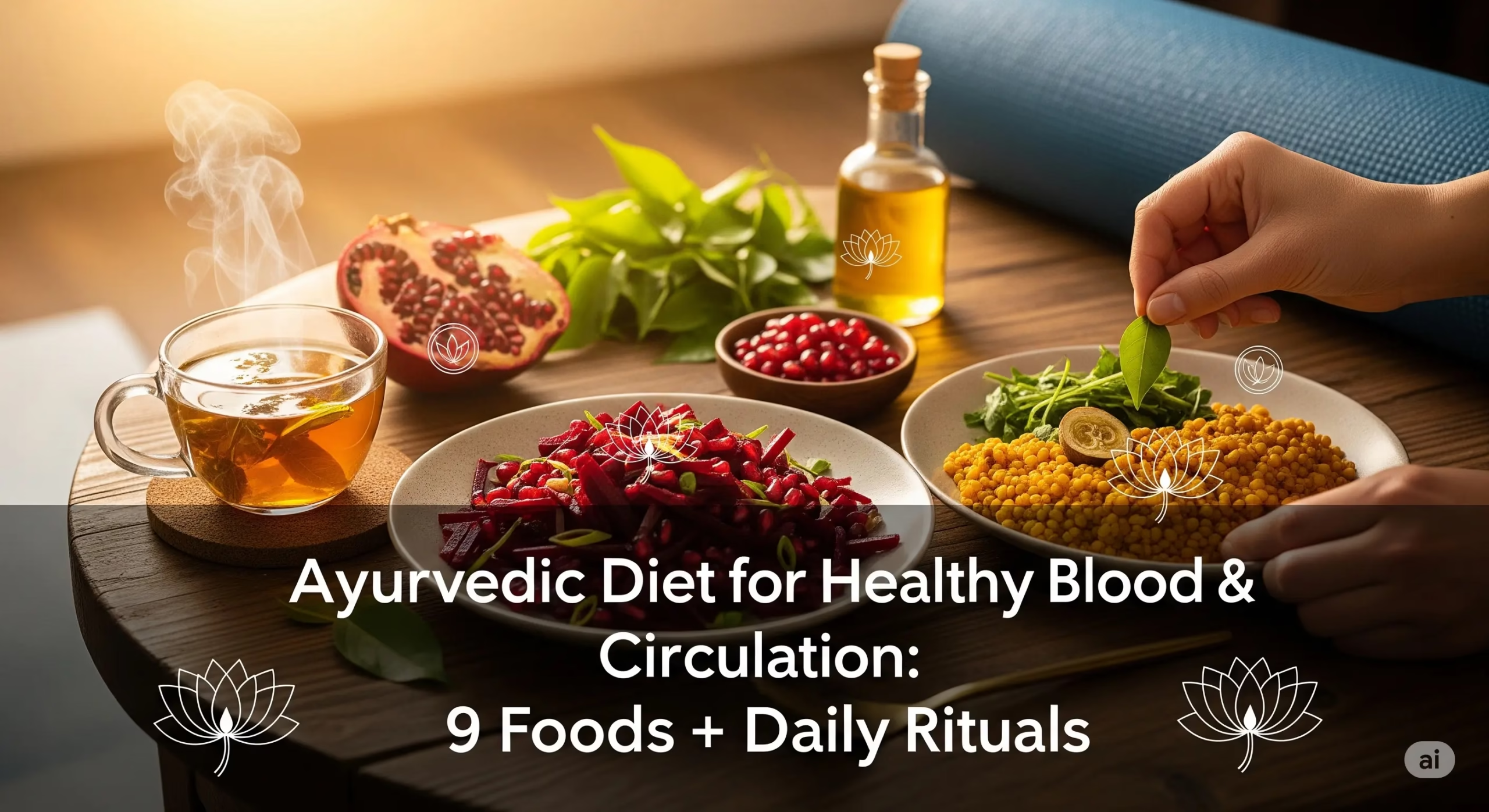Ever notice how sluggish you feel after days of greasy takeout or too little sleep? Cold hands and feet, brain fog, or unexplained fatigue might be more than just temporary woes—they could signal your blood and circulation need support. Ayurveda, the 5,000-year-old science of holistic health, teaches that rakta dhatu (blood tissue) isn’t just about physical fluid—it’s the river of life carrying prana (vital energy) to every cell. And in 2025 and beyond, generic wellness advice won’t cut it. People crave answers that solve real, daily struggles. Let’s explore how Ayurveda’s timeless wisdom—herbs, sattvic foods, and mindful habits—can revitalize your blood health and fit seamlessly into modern life.
What Ayurveda Says About Blood (Rakta Dhatu) & Circulation
In Ayurveda, blood isn’t just a bodily fluid—it’s the essence of vitality. Rakta dhatu nourishes tissues, carries oxygen, and removes toxins. But when circulation falters (think sedentary lifestyles, stress, or poor diet), toxins accumulate, leading to fatigue, cold extremities, dull skin, and weakened immunity. Unlike quick fixes, Ayurveda focuses on root causes: “Ama” (toxic buildup) from processed foods or unresolved stress thickens the blood, slowing its flow. Poor circulation isn’t just a “vein issue”—it starves your organs of prana, setting the stage for chronic imbalances. For deeper insights into balancing Rakta Dhatu, explore resources like Banyan Botanicals or the Ayurvedic College Blog.
Key Takeaway: Healthy blood = vibrant energy. Let’s rebuild it before problems arise.
Unlock the Secrets of Ayurvedic Anti-Aging: Triphala & More.
The Ayurvedic Diet Foundation for Clean, Nourished Blood
Ayurveda’s sattvic diet isn’t a trendy cleanse—it’s a timeless way of eating to nourish both body and mind. Sattvic foods are fresh, seasonal, and minimally processed, designed to create ojas (vitality) and keep blood pure. Think of them as nature’s “clean energy” sources: ripe fruits, leafy greens, whole grains, nuts, and legumes. For a deeper dive into Sattvic principles, explore this Ayurvedic Guide to Sattvic Foods, which explains how these foods harmonize body and mind. But here’s the catch: even healthy foods can turn toxic if eaten mindlessly.
Why Sattvic Eating Supports Blood Health
- Balances Pitta & Kapha: Sattvic meals cool Pitta (reducing inflammation) and lighten Kapha (preventing sluggish blood flow).
- Reduces Ama: Processed, oily, or cold foods (like ice cream or leftovers) create sticky toxins (ama) that clog circulation.
- Delivers Nutrients: Iron-rich greens, vitamin C-packed fruits, and zinc-loaded seeds rebuild rakta dhatu at the cellular level.
Foods to Avoid (or Minimize)
- ❄️ Cold drinks & ice: Constrict blood vessels, slowing circulation.
- 🍟 Processed snacks: High salt and preservatives thicken blood.
- 🍔 Deep-fried foods: Overwork the liver, leading to impure blood.
- 🥫 Stale or canned foods: Lack prana (life force), making digestion sluggish.
Pro Tip: Swap cold salads for lightly steamed veggies, and trade sugary desserts for baked apples with cinnamon. Ayurveda isn’t about deprivation—it’s about upgrading choices to feel vibrant.
5 Ayurvedic Tips to Quit Tobacco Naturally – Read Now

Foods That Naturally Purify & Strengthen Circulation
Ayurveda’s superfoods aren’t just nutrient-dense—they’re medicine for your blood. These picks tackle modern issues like sluggish flow, inflammation, and low energy by addressing root causes. Here’s your grocery list for vibrant circulation:
| Superfood 🌱 | Key Benefits 🔥 | How to Use 🍴 |
|---|---|---|
| Beetroot 🍠 | Improves blood flow, lowers blood pressure (nitric oxide booster). | Grate into salads, blend into soups, or juice. |
| Pomegranate 🍇 | Boosts iron, fights artery plaque, supports heart health. | Sip fresh juice or sprinkle seeds over oatmeal. |
| Guduchi (Giloy) 🌿 | Detoxifies blood, strengthens immunity. | Steep dried stems in tea or take as a supplement (consult a practitioner). |
| Turmeric 🌟 | Thins sticky blood, reduces inflammation (pair with black pepper for absorption). | Add to golden milk, soups, or stir-fries. |
| Triphala 🍒 | Purifies blood via gut detox (amla, bibhitaki, haritaki blend). | Soak 1 tsp in warm water overnight; drink on an empty stomach. |
| Ashwagandha 🍂 | Eases stress-induced poor circulation, boosts energy. | Stir powder into lattes, smoothies, or warm milk. |
| Coriander Seeds 🌱 | Flushes heavy metals, cools inflammation (balances Pitta). | Soak 1 tsp overnight; drink the water or chew seeds. |
| Spinach & Greens 🥬 | Rebuilds red blood cells with iron + chlorophyll (nature’s hemoglobin). | Lightly sauté with garlic + ghee for better iron absorption. |
| Sesame Oil 💧 | Unblocks stagnation, warms tissues (ideal for cold climates). | Use for cooking or daily self-massage (abhyanga). |
Pro Tip: Rotate these foods seasonally. For example, favor pomegranate in fall (Pitta season) and sesame oil in winter (Vata season).
Natural Ayurvedic Remedies to Ease Menstrual Cramps.
Simple Daily Practices That Help Keep Your Blood Flowing
Modern life—sitting all day, scrolling stress, and AC-induced chills—is a recipe for stagnant blood. Ayurveda’s dinacharya (daily rituals) counteract this with tiny, intentional acts. No hour-long yoga sessions required—just consistency. Here’s how to weave movement and warmth into your routine:
- Abhyanga (Self-Massage) with Warm Oil 🪔
Why: Massaging sesame or coconut oil into your skin boosts circulation, calms nerves, and thins ama (toxins) stuck in tissues.
How: Spend 5–10 minutes massaging upward strokes on limbs and circular motions on joints. Shower afterward to avoid greasiness. - Gentle Yoga for Circulation 🧘♀️
Poses to try:- Sun Salutations: 3–5 rounds jumpstart blood flow.
- Legs-Up-the-Wall: Drains stagnant blood from legs.
- Cobra Pose: Opens the chest, improving heart circulation.
- Hydrate with Warmth ☕
Skip the ice water: Cold drinks shock your digestive fire (agni). Sip warm water, ginger tea, or cumin-coriander-fennel (CCF) tea instead. - Avoid Cold Exposure 🥶
Feet & Lower Back: Keep these areas warm (socks, scarves)—Ayurveda sees them as gateways for cold to disrupt circulation. - Walk After Meals 🚶♀️
Why: A 10-minute stroll kickstacks digestion and prevents blood from pooling in your stomach.
Pro Tip: Pair habits! Do abhyanga before yoga to warm muscles, or sip CCF tea during your post-meal walk.

Traditional Herbal Teas That Keep You Warm & Flowing
Cold hands, sluggish mornings, or that mid-afternoon energy crash? Ayurveda’s herbal pantry offers more than just cozy drinks—these teas are targeted tools to thin sticky blood, warm your core, and keep circulation humming. Best part? They’re kitchen-friendly and take minutes to brew.
Top Herbs for Blood Flow
- Cinnamon 🪵: Dosha-friendly warmth
Opens blood vessels, balances blood sugar, and fights inflammation. Perfect for Kapha/Vata types. - Fresh Ginger �: Stokes agni (digestive fire)
Boosts circulation to extremities (goodbye, icy toes!). Avoid if you have high Pitta or acid reflux. - Tulsi (Holy Basil) 🌿: Adaptogen for stress-induced stagnation
Eases cortisol’s grip on blood vessels. Ideal for desk workers or chronic stress. - Fennel Seeds 🌼: Detoxifies blood, cools Pitta
Flushes excess heat from the liver (key for clear skin and steady energy).
3 Easy Ayurvedic Tea Blends
- Morning Reviver ☀️
*1-inch ginger (sliced) + 1 cinnamon stick + ½ tsp fennel seeds*
Simmer in 2 cups water for 5 mins. Strain and sip to ignite circulation. - Afternoon Reset 🕒
*1 tsp tulsi leaves + ½ tsp coriander seeds + 1 cardamom pod*
Steep in hot water for 3 mins. Add honey to soothe stress-induced sluggishness. - Bedtime Purifier 🌙
½ tsp triphala powder + pinch of turmeric + warm almond milk
Mix and drink 2 hours post-dinner to detox blood overnight.
Caution: Herbs are potent! Stick to 1–2 cups daily unless advised otherwise. Consult an Ayurvedic practitioner if pregnant, on blood thinners, or managing chronic conditions.

Don’t Ignore These Signs of Poor Circulation
While Ayurveda empowers you to take charge of your health, some signs scream, “Call a pro!” Persistent symptoms often signal deeper imbalances or chronic conditions that need personalized care. Here’s when to pause the DIY fixes and seek guidance:
Red Flags to Watch For
- 🧊 Chronic cold hands/feet (even in warm rooms)
- 🔌 Numbness or tingling in limbs (like pins-and-needles that won’t quit)
- 🧠 Persistent brain fog or memory lapses
- 🏋️ Unexplained fatigue that rest doesn’t resolve
- 🩸 Visible issues: Pale/bluish skin, swollen veins, or slow-healing wounds
Chronic Conditions Need Extra Care
If you have diabetes, hypertension, varicose veins, or a history of blood clots, poor circulation isn’t just a lifestyle issue—it’s a risk factor. Ayurveda can complement your care, but always coordinate with your doctor and an Ayurvedic practitioner.
Why Prakriti & Dosha Matter
Your unique constitution (prakriti) dictates which herbs, foods, and habits will work best. For example:
- Pitta types with inflammation may need cooling herbs like coriander.
- Vata types with cold limbs might require warming oils and grounding diets.
- Kapha types with sluggish flow could benefit from pungent spices like ginger.
An Ayurvedic expert will analyze your pulse, tongue, and lifestyle to craft a plan that’s yours—not a generic Google solution.
Pro Tip: Track symptoms for 2 weeks before your consultation. Note when they flare (e.g., after stress, certain foods, or weather changes). Patterns help practitioners pinpoint doshic imbalances.
Start Small: One Ayurvedic Change at a Time
Let’s be real: Overhauling your diet and lifestyle overnight is a recipe for burnout. Ayurveda isn’t about perfection—it’s about progress. Maybe you add a pinch of turmeric to your morning eggs, swap your iced latte for ginger tea, or massage your feet with sesame oil while binge-watching Netflix. Tiny, sustainable shifts compound into real results.
Remember: Ayurveda is a 5,000-year-old conversation between you and your body. Some days, you’ll crave beetroot salads and yoga flows; other days, you’ll need rest and comfort food. That’s okay. The goal isn’t rigid rules—it’s noticing how your energy, skin, and mood respond when you prioritize clean blood flow.
CTA: Try one thing today:
- Blend beetroot into your smoothie.
- Sip cinnamon tea instead of cold brew.
- Take a 5-minute walk after dinner.
Your blood doesn’t need a revolution—just consistent, loving care. After all, in 2025 and beyond, the best health hack is the one you’ll actually stick with.
